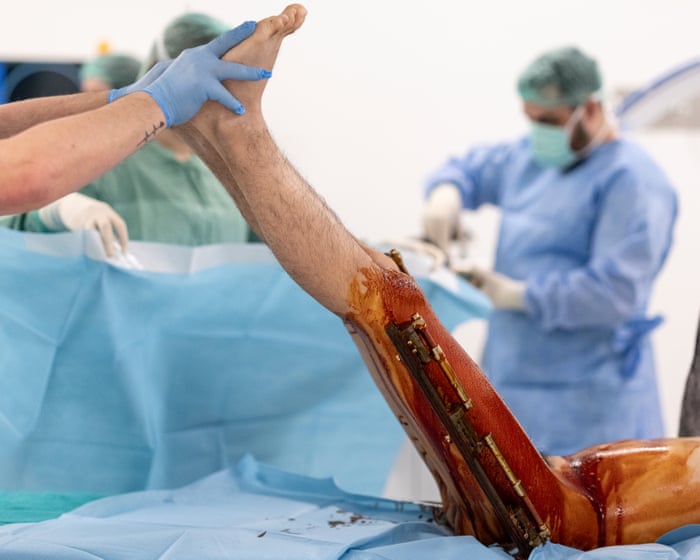Häämatkallaan Kuala Lumpurissa Frank seisoi hotellinsa ikkunan ääressä tuijottaen loistavia kaksoistorneja – maailman korkeimpia pilvenpiirtäjiä – kun hän päätti, että oli aika kasvaa pidemmäksi. Hän oli äskettäin kertonut uudelle vaimolleen, kuinka hänen pituutensa oli kummitellut häntä teini-iästä lähtien. Itseensä kehittämiseen sitoutunut mies ryhtyi toimeen. Hän soitti turkkilaiselle klinikalle, joka erikoistui jalkojen pidentämiseen, ja varasi leikkauksen.
"Minulla oli epäilyksiä – loppujen lopuksi joku aikoi murtaa jalkani", Frank myöntää istuessaan Istanbulin hotellihuoneen sängyllä, jalat sidottuina tukirautoihin. Hänen vaimonsa Emilia auttaa häntä kipulääkkeiden ja jääpussien kanssa, joita käytetään rautojen lävistämien haavojen hoitoon. Ensimmäisten kahden viikon aikana leikkauksen jälkeen hänen piti auttaa Frankiä jopa vessassa käymisessä. Nyt, kuuden viikon jälkeen, hän tarvitsee apua lähinnä sängystä nousemisessa.
Hälytys keskeyttää keskustelumme – aika kääntää avainta. Frank työntää sen reiteen kiinnitettyyn metallitukeen ja kiertää sitä erottaakseen reisiluihin istutetut tangot. Jokainen kierros pakottaa uutta luuta kasvamaan rakoon, millimetri kivuliaan millimetrin jälkeen. Lääkärit suosittelevat neljää kierrosta päivässä, mutta Frank työntyy viiteen, irrottaa ylimääräisen neljännesmillimetrin pituutta. "Kasvun aika!" Emilia vitsailee hälytyksen päästessä ääntä.
173-senttinen Frank, 38, hieman alle miesten maailmanlaajuisen keskipituuden, on aina tuntenut itsensä "lyhyeksi". Mutta Istanbulin Wanna Be Taller -klinikalla lyhyys on suhteellista. Jotkut potilaat yltävät yli 183 senttiin. Eräs mies kertoo tarvitsevansa leikkauksen kuperien jalkojen korjaamiseksi ja päätti samalla kasvattaa pituuttaan. Harvinainen naispotilas, entiseltä pituudeltaan 160 cm, tuijottaa minua ilmeettömänä ja toteaa, että yhteiskunta vieläkin hyväksyy pituuspohjaisen syrjinnän – syy, miksi hän halusi kasvattaa pituuttaan viisi senttiä. (Klinikka tarjoaa myös jalkojen lyhentämistä, mutta vain yhdeksän potilasta – enimmäkseen naisia – on valinnut sen.)
Frank tavoittelee Emilian 165-senttisen pituuden ylittämistä kasvattamalla itsensä 9 cm – hieman yli lääkärien turvalliseksi pitämän 8,5 cm. Tämä tekisi hänestä 175-senttisen, hänen unelmansa: keskipituuden. Viisi päivittäistä kierrosta tarkoittavat yli millimetrin kasvua päivässä kymmenen viikon ajan. "Joskus hermojen aiheuttama kipu on sietämätöntä", hän myöntää.
Itseään "tavoitteelliseksi" kutsuva Frank on tatuoinut käsivarsiinsa "self-made" ja Schwarzeneggerin kasvot reiteensä – nyt venyvänä kasvun myötä. "Valitsen oman pituuteni", hän sanoo. "Jos haluan jotain, teen sen eteen töitä. Kunnes saan sen, se jää vaivaamaan minua."
Ulkopuoliselle prosessi näyttää keskiaikaiselta kidutukselta. Aiemmin näin Frankin irvistävän kivusta, kun fysioterapeutti nosti hänen jalkojaan, ja hänen jännevälineensä vastustivat kuin tiukat köydet. Silti hän kestää, ajettuna lupauksesta seistä pidempänä – yksi kivulias kierros kerrallaan.
Hän saattaa hajota. Hän on toipumassa ensimmäisestä kahdesta leikkauksesta – tässä leikkauksessa hänen reisiluunsa murtettiin ja niihin asennettiin metallitangot sekä ulkoiset kiinnikkeet. Toinen leikkaus, joka on suunniteltu kolme kuukautta myöhemmin, poistaa kiinnikkeet, kun pidentäminen on valmis. Jotkut potilaat päättävät murtaa myös sääriluunsa tai sen sijaan saadakseen lisää pituutta.
Vaikka jalkojen luiden murtaminen kuulostaa tarpeeksi kivuliaalta, todellinen kärsimys alkaa jälkeenpäin. Istanbulin laitamilla sijaitsevassa hotellissa – joka näyttää rakennetun kipsilevyistä ja keinokullasta – noin 20 jalkojen pidentämispotilasta viettää päivänsä venyttäen lihaksiaan ja jännevälineitään sopeutuakseen kasvaviin luit




